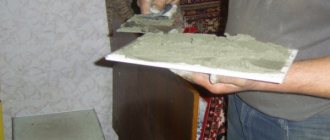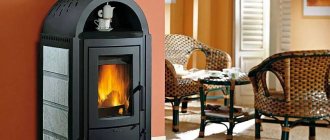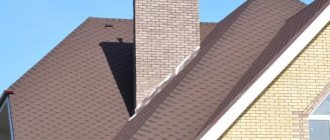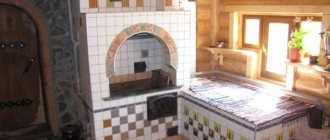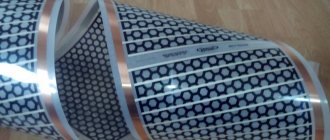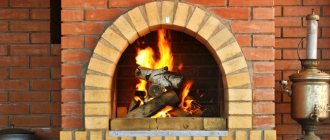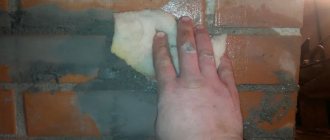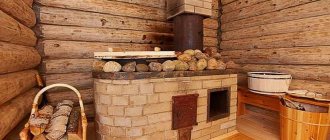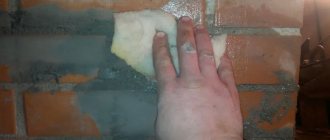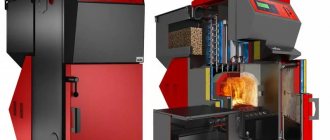One of the signs of the convenience of living in a private cottage is its consistently comfortable environment at any time of the year. No matter how beautiful the structure, only a warm house can be truly cozy. One of the best solutions is to organize heating using a brick stove for the home. The advantages of this material are obvious - the variety of shapes allows brick stoves to harmonize with any environment, and the heat transfer characteristics are among the best.
With proper design and installation, a brick oven can also be used in wooden houses Source taldomstroi.ru
What types of brick stoves are there for houses?
Brick stoves intended for residential buildings are divided into the following types:
- Heating. The main purpose is to provide heating for individual rooms or the entire house;
- Cooking. The design is designed in such a way that the main heat flow goes upward - to the hob. Such a stove is heated only during cooking;
- Heating and cooking. Essentially, it is a heating stove with a hob. Since such a stove has a mixed functional purpose, cooking food on it in the summer is not always comfortable.
Whatever type of stove it is, some general qualities must be present in any case:
- the oven should warm up well;
- the chimney design must provide good draft;
- high level of general fire safety;
- the stove should fit harmoniously into the overall environment, creating a feeling of comfort.
Based on the shape of the product, brick kilns are divided into square, round, corner, T-shaped, and rectangular.
Heat transfer is primarily affected by the thickness of the walls of the product. Based on this parameter, furnaces are made of thick-walled, thin-walled and combined types.
The thickness of the walls is determined not only by the number of bricks, but also by the method of laying them Source akson-quick.ru
Advantages and disadvantages of a brick stove in the house
There are several reasons why a brick stove for a home is more preferable than products made from other materials:
- The design, thought out to the smallest detail, perfectly serves as a heat storage device. It is this feature that allows you to fire a brick stove much less often than other analogues (steel, cast iron). The heat retention period is about 24 hours. For comparison, firewood should be added to metal stoves every 5-6 hours;
- Due to the high accumulation of heat, a brick oven is highly economical and less harmful to the environment, which cannot be said about its metal counterparts. Optimal combustion of fuel gives maximum heat transfer; almost complete decomposition of organic matter is observed - splitting into carbon dioxide and a water base. Excess heat heats the masonry, which in turn warms the rooms;
- There is no effect of incandescence on the outer parts, so the thermal radiation of brick structures is much softer than that of steel ones.
On the outside, the bricks are hot, but not red-hot, unlike iron parts Source minsknews.by
This is interesting! When heated, the moisture condensed in the pores evaporates from the bricks, and when cooled, it is absorbed back. This process is commonly called stove breathing and thanks to it, the humidity level of the heated air always remains comfortable - from 40 to 60%. Other heating devices require the installation of an additional humidifier; without it, the air dries out.
Also, a stove in a brick house is not without its disadvantages:
- The long cooling of the brickwork, scientifically called thermal inertia, is a big plus, but this coin also has a downside - an equally long warm-up. Therefore, when lighting a stove in a cold room of a large area, the temperature in the house will rise slowly - this is especially felt in the far corners. In this case, it is additionally recommended to purchase a convector.
- Since a brick oven is a fairly massive structure, ideally it is erected simultaneously with the house. The furnace must function without interruption, so special knowledge and experience are needed to design and build it. Even despite free access to drawings with orders for brick stoves for the home, you can’t do this without a specialist, and good stove craftsmen are in short supply.
For high-quality laying of stoves, it is not enough just to know the order - this work has many nuances, knowledge of which comes only with experience Source fasaddomstroy.ru
See also: Catalog of companies that specialize in the installation of fireplaces and stoves
It is better to heat the stove with wet rather than damp wood...
Yes, that's true, but it's a joke. It is better, of course, to heat the stove with dry wood. Let's take a closer look at what dry, wet, wet and damp firewood is...
Wet firewood
Freshly cut firewood is considered damp. The relative humidity of such firewood is 50-100%. In such firewood, not only the intercellular space is filled with moisture. The pores through which moisture is delivered to the foliage - “channels”, “tracheids”, whatever you want to call them) - are also filled with moisture.
Damp firewood will not give the required temperature, if at all it burns and does not smolder. The fact is that for rapid evaporation of moisture in firewood, a significant temperature is needed. If you put a raw log in a hot firebox, it may even increase the intensity of the chemical processes of oxidation - combustion. After all, water begins to burn at high temperatures. But this is a topic for a separate article.
So, damp firewood will not provide the required temperature for ignition - there will be problems with melting it. Even if you melt such an armful, the moisture from the firewood will not go anywhere, but will fill the stove channels and can form an air lock. A combination of factors - low temperature of burning gases (in wet wood) and air humidity in the stove - will cause problems with draft.
Wet firewood
We accept firewood dried outside as conditionally dry, its relative humidity is 20-30%. But such firewood is quite hygroscopic. They can both quickly gain moisture and quickly release it.
Firewood with a relative humidity of 30% or more can be called wet, although it may appear dry. The fact is that moisture in the tracheid canals of wood evaporates faster than intracellular moisture. Therefore, firewood with a moisture content of up to 30% is conditionally dry firewood. This is the moisture content of firewood that is normal for outdoor drying.
Firewood that has been exposed to rain or soaked in anything is wet firewood. But this does not mean that they are raw. Firewood exposed to rain, if it was not damp, is still better than raw firewood, even if it appears dry. Well, something like this…
Now about dry firewood.
Which brick to choose for the stove
When choosing a brick, attention is primarily focused on its resistance to temperature influences. The building material must withstand repeated heating and cooling procedures. The overall service life of the stove depends on the characteristics of the brick from which the stove will be made.
It is customary to mark bricks. One of the main indicators is density and strength grade. The denser the product, the slower the kindling and heating will occur. To build a stove, you need bricks whose markings indicate strength grade M150-250, with maximum thermal conductivity and minimum hygroscopicity.
Note! Density itself is not a sign of quality. A strength grade that is too high may indicate the presence of substances in the brick that are harmful to humans when heated.
The next marking indicator is the level of frost resistance, which should be the highest. It plays an important role when choosing products used in laying the chimney (especially the part protruding above the roof).
Marking of bricks for stoves in comparison with other types of material Source iqlevsha.ru
Frost resistance implies the ability of a product to absorb moisture. Its crystallization inside the material can cause deformation of the latter. Hollow facing ones are better suited.
When forming the inside of the chimney, you need solid red brick. Plastic molding is preferred. These products withstand temperature changes and do not crack even with significant downtime.
Use in the construction of furnaces is contraindicated:
- silicate and pressed bricks;
- bricks made using the slip casting method;
- unfired raw materials.
The maximum aging of fireclay bricks (made in accordance with GOST) is up to 1350 °C. It is quite possible to use such products to create most of the structure or to use them separately for thermal protection (lining) of internal surfaces.
The Sh8 brand is suitable for the firebox (such bricks have a straw-yellow color and darkish inclusions). For the arch of the firebox, it is recommended to use fireclay products (W 22-Sh45). The only exception is sauna stoves, where due to high humidity, such bricks are contraindicated.
Sh8 brand refractory brick has a straw-yellow color Source pcentr.by
Features of the construction of a Russian stove
This design performs several functions simultaneously:
- heats the room;
- serves as interior decoration;
- suitable for cooking;
- if there is a bed, it is used for sleeping or relaxing.
The list of tools and materials will be the same as for building a sauna stove.
Tools for building a furnace
Prices for building levels
Construction levels
Important! If construction work takes place in winter or late autumn, you need to monitor the temperature of the materials so that it does not fall below +5 degrees.
Carrying out masonry
The whole process is divided into certain stages:
- Laying waterproofing and row No. In the corners, bricks ¾ in size are used, a total of 3 pieces are needed. for each corner with a seam thickness of 4-5 mm. After each row, the horizontalness of the masonry is checked using a level.
- The next row is made of solid red brick with a gap for baking. The remaining mortar is removed from the bricks with a damp cloth. 2 more rows are performed in the same way.
- Starting from row No. 5, the arch of the oven is made. For ease of installation, wooden formwork is installed. Each brick is pressed close to the next. Row No. 8 closes the vault.
- Rows No. 9 and 10 are made into one brick, leaving a gap for arranging the substructure. To get more heat from the stove, the space above the vault needs to be filled with a mixture of sand and broken glass. Row No. 11 acts as a cover.
- For row No. 12, fireclay bricks are used. The gaps between the bricks are filled with sand. It will be under. An opening is made on the left for coals.
- For the following rows, the seam thickness should be in the range of 2-2.5 mm. The bricks are laid edgewise. Row No. 16 serves as a vault for the crucible. Its laying starts from the edge and ends in the middle.
- A pole window is made in the shape of an arch. During the installation of row No. 20, the free space above the hearth is reduced due to the construction of the furnace walls. On row No. 21, this gap is shortened even further and a re-pipe is made.
- On the next row, the overtube is made smaller. A channel for the samovar is being laid. On row No. 23 an opening is created for cleaning the chimney.
- Starting from row No. 24, the overpipe is blocked. Here they leave space for views. The door is being installed. With its help, the view will be easy to open and close.
- On row No. 29, the samovar needs to be connected to the overpipe. On row No. 32 it is covered with solid brick masonry. There should be one hole left, blocked by the flap.
Video - How to install a fire door
After this, you can begin laying the chimney. The formwork can be removed after a week when the solution has hardened.
Prices for fireproof mortar for stoves and fireplaces
Fireproof mortar for stoves and fireplaces
Ordinal scheme
Features of the chimney arrangement
Traditionally, a straight chimney is made. Then carbon monoxide will be directly released into the street. The optimal width of the chimney pipe is 26 cm. Its height will be influenced by the horizontal gap between it and the ridge.
Important! To make it more convenient to carry out construction work, you can use special scaffolding. Their second name is “goats”. They are especially useful for laying the top rows, and the width of the working surface allows you to install containers with masonry mixture on them.
Table 2. Chimney height
| Distance to ridge | Height in relation to the ridge |
| Up to 1.5 m | From 0.5 m above it |
| 1.5-3 m | Along the ridge line |
| From 3 m | Just above the ridge line |
Important! The chimney must be quite stable, because in addition to internal factors - overheating and temperature changes - it will be affected by the external environment - precipitation, wind.
When constructing a chimney, it is advisable to take into account the following nuances:
- The walls of the structure must be dense so that carbon monoxide and smoke do not enter the room. To do this, the seams are made carefully. There should be no holes or voids in them. The thickness of each seam should be no more than 1 cm.
- After finishing the masonry, the outer surface of the chimney is covered with mortar and whitewash.
- The part of the chimney that is located above the roof must be covered with a layer of cement plaster. This will protect it from rain and snow.
- A spark arrester - a special metal mesh - is mounted on the chimney pipe, located above a highly flammable area of the roof.
Where the chimney is in contact with the ceiling, it needs to be expanded - cut. This value depends on the degree of protection of this area from ignition.
Roof fire protection
Remember! In the absence of fire protection, the size of the cutting will be 0.5 m, and if it is available - 0.38 m.
They do it without direct support on the roof. If the furnace settles, it may differ from the settlement of the building itself, and then there is a possibility of damaging both the cutting and the roof. The material from which the decoration on the ceiling is made is brought to cutting. If there is a second floor above the stove, then the floor above the cutting area should be made of fireproof material. This area can be made of stone or concrete.
How to determine the optimal location of the furnace
The location in the house for the stove must be determined according to certain parameters. The following indicators are taken into account:
- area of a residential building;
- how many rooms should be heated;
- what is a stove for and what type?
- how gases will be removed during combustion;
- the location of the stove must comply with fire safety requirements.
The stove should heat every room in the house as evenly as possible. If this condition is not met, either an additional furnace or water heating system equipment will be required.
To heat the rooms adjacent to the kitchen, a heating and cooking stove is used. It is placed in the kitchen, and the rest of the rooms are heated by the heat-dissipating wall.
When building a house made of stone, you can immediately think about the placement of chimneys in the walls, which will increase the usable area of the house and ensure optimal heating.
When placing the stove on the border of rooms, you need to think about the place where it can be most successfully placed so that the surfaces transferring heat from the stove allow for uniform and maximum heat distribution.
Options for placing the stove in the house Source pechnoy.guru
Typically, the place to place the firebox is a hallway or kitchen. If the stove is designed well, it is almost invisible in the house. It does not clutter up the living space and is in perfect harmony with all interior elements. For example, a combination option is often used. In one room there is one side of the building - a stove, and in the adjacent room, its second part is a fireplace. The chimney system is common.
A brick stove for a home cannot be called mobile, so planning a place for it requires attention. We should also not forget that the oven requires regular maintenance, which means that convenient approaches must be carefully thought through.
Furnace foundation
Since the specific gravity of the entire structure is high, it needs a strong foundation.
- Furnace foundations are divided into the following types:
- reinforced concrete;
- pile;
- pile-screw;
- columnar;
- made of blocks.
It is important! Whatever type of foundation the foundation belongs to, it must be created separately from the base of the house (except for a monolithic slab). The choice of foundation depends on the soil on which it will be laid.
- The gravel-sandy soil type requires the preparation of a shallow foundation;
- For clayey or sedimentary soil, the foundation is poured using a crushed stone cushion;
Differences between arranging the foundation for a brick and iron stove Source kaksdelatbanyu.ru
- In the permafrost zone, a pile-screw foundation is used;
- Dry rocky soils make it possible to get by with either a minimal base thickness or not use it at all;
- The stove cannot be installed in areas of bulk soil.
Stages of arranging the base for a brick kiln:
- Taking into account the type of soil and the depth of its freezing, a pit is prepared.
- The bottom is compacted with horizontal alignment. Crushed stone, broken brick and rubble stone are poured in an even layer. Tamping again.
- A solution is prepared (proportion 1:3). The embankment is filled with mortar;
- Then there are three options:
- use a combination of crushed stone and cement;
- apply a frame made of reinforcement and then fill it with concrete;
- a reinforced concrete slab is poured, on which the foundation is made from bricks and concrete and rubble pouring.
Move on to the next steps after all the used solution has dried.
- Laying three-layer waterproofing.
- Next, bricks are laid in rows.
Bricks that have been stored in the open air cannot be used in construction. Due to repeated freezing and getting wet, they become brittle, which will reduce the service life of the stove.
The procedure for laying the furnace
How to properly build a stove in a house depends on the materials used and the chosen design, but the main stages of work are always the same:
- The beginning of the creation of the stove - the first two rows of bricks form its flood part;
- Laying the third row of bricks - a blower door is installed in it;
- Laying the fire part;
- As soon as several rows are laid out, a grate is installed above the ash chamber. It is placed on fireclay bricks;
- The combustion door is installed. The combustion chamber is formed;
- A hob is placed on top of the combustion chamber;
- Continuation of masonry with the gradual design of a gas convector system;
- When the body of the stove is formed, they proceed to the construction of the chimney.
Materials and tools
Regardless of the type of stove chosen, the work involved in their construction is very similar, and the structures themselves have minor functional differences from each other. On the technical side, they will differ in versatility, degree of impact and size.
The initial building materials for the construction of brick kilns are:
- wire
- lime with sand
- clay
- brick
When purchasing the latter, you need to ensure that it is in the correct shape and has a sufficient level of firing.
To prepare the solution, you can use refractory, red or even ordinary clay. You will also need auxiliary equipment, which can be purchased in the markets:
- Required doors and dampers
- Views and sliders
- Grate grates
- Cookers with burners, etc.
In addition to materials and components for the stove, you will need to prepare a set of working tools (level, plumb line, milk brush, usually a stove-maker's hammer, level, etc.).
Find out how to make a furnace that runs on waste oil
Installing oven doors
Depending on the design of the stove, folding, lifting, sliding or classic doors are installed.
When choosing a door material for the stove, take into account the following points:
- cast iron structures with glass inserts or all-glass products are chosen if the house likes to admire the play of flames;
Through the glass you can clearly see how the fire is burning in the stove Source idei-landshafta.ru
- All cast iron samples are used if the stove is fired with coke, coal or mixed fuel. Doors made of steel or glass are suitable for a wood-burning stove;
- To avoid burns and protect children or pets from dangerous environments, a metal door with an additional thermal shield is required.
The selected doors are installed at the appropriate stage of laying brick stoves, according to the given scheme.
Rules for operating a brick stove
In order for the stove to serve for a long time, you must follow certain operating rules:
- The consistency of the stove's characteristics is ensured by maintaining the integrity of its body. Even a small crack of 2 mm in the area of the valve will lead to a loss of 10% of the heat generated during fuel combustion.
- The stove should be heated correctly. Heat loss when the blower is open reaches 15-20%. If the firebox door is open during combustion, all 40% will escape into the open air.
- For the firebox, be sure to use dry firewood, prepared in advance. When using raw materials, less heat is generated and due to the formation of caustic condensation, the brick walls are destroyed.
- Uniform heating is possible only when burning approximately identical logs - from 8 to 10 cm thick.
Kindling methods
How to properly heat a Russian stove? In winter and in the off-season, the stove is heated once or twice a day, in the warm season - as needed. First, the internal space is freed from the remains of coals and ash, dishes and other foreign objects are removed. To understand how to light a Russian stove, you need to know some nuances. For kindling, one of two methods is usually used.
Warning: the presence of traction depends on three parameters. The design of your stove, weather conditions (temperature differences and wind) and the cleanliness of the chimneys. In order not to spend money on the services of professional chimney sweeps, you should annually clean the chimneys and other cavities of the Russian stove from soot and ash residues.
Kindling in the firebox container
The most economical way is considered to be kindling firewood in the firebox. In this case, the walls of the Russian stove are heated evenly, and fuel is consumed economically.
How to properly heat a Russian stove with wood? The logs are placed tightly in the firebox and almost the entire volume is filled with firewood. After the firewood is occupied, you should close the mouth damper tightly.
We fill almost the full volume
It is more convenient to light a fire with this installation using the top method. Kindling from birch bark, paper and splinters is placed on top of the stacked logs.
If there is smoke in the room, then to improve draft, move the ventilation valve literally two to three centimeters. When the smoke dissipates, the valve is returned to its original position.
For stable combustion, it is necessary to control the constant access of oxygen to the firewood. Therefore, they periodically stir up the logs with a poker. Then oxygen penetrates to the lower layers, and the combustion process intensifies. Before opening the damper, close the blower. This trick reduces the flame and the likelihood of smoke in the room.
When the first portion of firewood burns down to the state of coals, they are pushed to the side with a poker. Now a second filling is carried out, its volume is approximately one third less than the first.
Kindling “in Russian”
The second method is called kindling “in Russian”. This method is suitable if there is no need to quickly warm up the room, the effect of fireplace combustion is needed, or when cooking food by simmering.
The ignition process in this case begins on the hearth. The view is covered and the ventilation is kept open. The logs are stacked in the shape of a well at the front edge of the furnace. The structure is set on fire and carefully moved towards the center.
Video description
To see the errors in the installation and operation of brick stoves, watch the video:
- Laying firewood should be done leaving an empty space of 10 mm between them. Firewood is loaded into the firebox in parallel rows or with intersections. The optimal option for filling the firebox is 2/3. The gap between the firewood stack and the top of the firebox should not be less than 2 cm.
- To ignite fuel, use ordinary paper, a torch, etc. Do not use flammable substances: gasoline, kerosene or acetone.
- As soon as the stove is lit, the view is covered a little, otherwise all the heat will immediately disappear.
- The reference point when adjusting the draft during kindling is the color of the fire. A yellow flame color is considered optimal. If the flame is white, this indicates an excess of oxygen - a lot of heat goes straight into the chimney. Red flame - there is not enough air, the fuel burns partially, releasing harmful substances into the air.
Instructions for firing the stove
Algorithm of actions:
- Place crumpled pieces of paper and thin wood chips in the grate area. You can put 1-2 small logs.
- Open the ash pan door by ¼ and the chimney valve by ½.
- Set the paper on fire using matches. After the fire has started, you should increase the amount of air supplied by opening the vent by ½.
- After the entire paper-wood structure has ignited, gradually add more wood as it burns out.
- Re-laying of firewood must be done when large coals have formed (about half an hour after the first laying).
- The combustion process is controlled by a valve and a blower.
A very important indicator that you need to pay attention to is the color of the flame. The color of the straw indicates a normal combustion process. If the flame has changed color and turned white, and you hear a strong hum in the outlet channels, then this is a sign of increased draft, you need to cover the ash pit. Red flames and black smoke from the chimney are indicators of insufficient draft; the vent needs to be opened slightly.
Video: how to light a brick oven with your own hands
How to drown in black
Special mention should be made of the nuances of firing a stove in black, although such devices are no longer as common as in past centuries. In modern times, baths are mainly heated in this way: the efficiency in this case is very high, much higher than in “white” baths. Little fuel is required for good heating.
Combustion products in such structures do not exit through the chimney, but through the windows and door. A lot of soot settles on the walls, but you should not be disdainful, since in this situation it acts as an adsorbent.
Procedure for black stoves (in the bath):
- Open the windows and door to bring in fresh air and maintain the combustion process.
- Stack the firewood in a “house”, placing scraps of paper under it and set it on fire.
- Before laying firewood for the second time, it is necessary to spill water on the walls and shelves.
- Gradually add firewood, finishing the fire when crimson light appears above the stones.
- It is necessary to wait until the last portion of firewood burns out and remove the coals remaining after that.
- Ventilate the room by opening the windows and door.
- Rinse doors and shelves with cold water.
- Splash a tub of water on the heater and close the doors.
First fire of the new furnace
If the stove is just folded and everything is ready for kindling, then remember a few useful rules.
Firstly, take your time and let the masonry dry. This may take 2–3 days. Light the stove, following all fire safety rules, and see if there is any smoke. Then touch the stove in different places, it should warm up evenly, without temperature changes. Also, the stove, folded correctly, should cool to the same extent.
Secondly, test the quality of the masonry. The density of the laid brick should not allow smoke to pass through. For this test, burn synthetic materials that smoke heavily in the firebox and see if smoke escapes.
If everything went well, the oven can be used!
You may find this material useful on how to properly build a brick oven yourself:.
Fire up the stove after a long period of inactivity
After winter, when you arrive at your dacha, you will want to warm up and light the stove. This must be done in such a way as not to cause damage to either the stove or the residential or bathhouse building itself.
First of all, you need to inspect the oven from the outside and inside to detect:
- cracks;
- chips;
- foreign objects;
- small animals and birds;
- excess soot.
All this can become an obstacle to the normal operation of the furnace. Chips and cracks must be eliminated by sealing them with mortar, and foreign objects must be removed. To clean the chimney of soot, you can use a special metal ball on a long rope. The ball, which is often equipped with a wire brush, is lowered “down the shaft” and raised up, repeating these manipulations several times, shaking off the soot after each rise.
A mandatory action before heating the stove after a long break is checking the draft. Firewood is set on fire with all doors open (ash pan, ash pit, fire door), then they are closed, adjusting the degree of exhaust.
Sometimes the lack of draft can be due to a large amount of cold air in the chimney. Therefore, heating the chimney part of the stove will help eliminate this problem.
We lay two logs parallel to each other at some distance, then place the other two on top of them, placing them perpendicular to the first row. It looks like a mini-well, inside which you need to place paper, a piece of birch bark and splinters.
A stove that has not been fired for a long time cannot be used at full capacity right away; try to ensure that the heating process is gradual, starting with short time intervals.
Proper fuel stowage
People who are far from the firebox of a stove may be surprised to learn that proper placement of fuel can affect the operation of this device.
The most commonly used methods for stacking firewood are:
- horizontal (rows of firewood follow each other with uniform distances between them);
- conical (they build something like a hut from logs);
- diagonal (the first log is laid diagonally in the firebox, all others - at an angle to it).
This is what one of the options for stacking firewood in the stove looks like
The firebox should not be filled to capacity; approximately a fifth should remain free.
When using coal, kindling is done with wood, then, when the fire flares up, a layer of coal is poured (about six centimeters). The height of subsequent layers can reach up to fifteen centimeters, but the coals must allow air to pass through well. It is advisable to stir the coals periodically using a poker or other special devices.
Warm up in the cold (including in winter)
The cold season, especially winter, requires more frequent use of the stove. When trying to warm the room as much as possible, you should not heat the stove too often or too much, as you can cause it to overheat. An overheated stove can collapse faster, the brickwork begins to crumble, burnouts appear in the channels, etc.
Therefore, heating in the winter season needs to be done wisely: heat the stove moderately, twice a day is enough. If you want to “add up the heat,” then conduct each subsequent fire at intervals of at least four hours.
